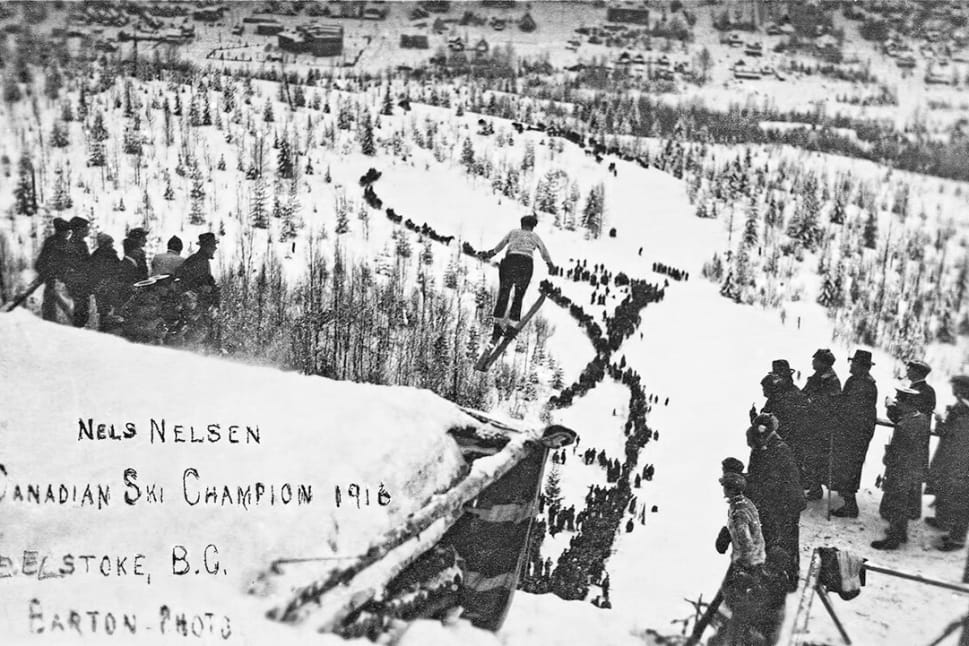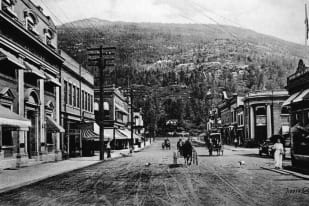A Record-Breaking Ski Jumper Who Put Canada on the Map
Nels Nelsen was one of the most accomplished ski jumpers of his time. His career spanned the early decades of the 20th century, a period when ski jumping was gaining recognition as a competitive sport. He arrived in Canada from Norway, set world records in ski jumping, and helped shape the sport in North America. His achievements remained unmatched for years, and his contributions influenced generations of ski jumpers.
From Norway to Canada
Nels Nelsen was born in 1894 in Norway, a country with a long history of skiing. He grew up in a place where ski jumping was common, and he developed an early interest in the sport. His family moved to Canada in 1913, settling in Big Eddy, British Columbia, near Revelstoke. When he arrived, he changed his name from Nils Johan Nilsen to Nels Nelsen.
Revelstoke was already known for its ski culture, and Nelsen quickly became involved. He joined the local ski community and helped organize ski tournaments. His presence brought more attention to the sport, and within a few years, Revelstoke became one of the top ski jumping locations in North America.
Building a World-Class Ski Jump
In 1914, Nelsen and local ski enthusiasts formed the Revelstoke Ski Club. One of their biggest goals was to improve ski jumping facilities. They selected a location on Mount Revelstoke for a new ski jump. The site, later known as Big Hill, had a natural slope that made it ideal for long jumps without requiring artificial towers.
The construction of Big Hill helped turn Revelstoke into a major ski jumping destination. The town hosted annual ski tournaments, attracting top athletes from Canada, the United States, and Europe. Over time, it became one of the best-known ski jumping hills in the world. It wasn’t just the length of the jumps that made the location stand out; it was the consistency with which records were broken there. Athletes saw Big Hill as a proving ground, a place where they could test their limits and push the sport forward.
Setting Records That Stood for Years
Nelsen set his first unofficial world record in 1916 with a jump of 55.8 metres (183 feet). His ability to consistently land long jumps earned him recognition beyond Canada. In 1921, American skier Henry Hall set a world record of 70 metres (229 feet) on Big Hill. Nelsen reclaimed the record in 1925 with a jump of 73.1 metres (240 feet). This remained the longest ski jump in the world until 1930.
For more than a decade, Nelsen was considered one of the best ski jumpers. He won multiple national and international competitions, bringing attention to Canada’s growing ski jumping scene. His skill and consistency helped elevate the reputation of Canadian ski jumpers in international competitions. He became known for his precision, ability to read the wind, and smooth landings. At a time when ski jumping techniques were still evolving, Nelsen was ahead of many of his competitors in both strategy and execution.
Missed Opportunities and Career Challenges
Despite being one of the top ski jumpers in the world, Nelsen never competed in the Olympics. In 1928, he planned to travel to the Winter Games in St. Moritz, but British Olympic officials rejected his self-funded trip. Without support from the Canadian team, he was unable to compete. This decision prevented him from showcasing his abilities on the world’s biggest stage.
It wasn’t just the Olympics where financial and political barriers held him back. Ski jumping at the time was still developing as an organized sport, and sponsorships were rare. Nelsen relied on local support and small event winnings to continue competing.
In 1933, his career ended after a hunting accident. He lost a hand, which made it impossible to continue competing. Although he could no longer jump, he remained involved in the sport and helped develop ski programs in Canada. He focused on coaching and worked to improve ski facilities in British Columbia.
Leadership and Lasting Influence
After retiring from competition, Nelsen took on leadership roles in Canadian skiing organizations. He served as president of the Western Canada Amateur Ski Association and later as vice-president of the Canadian Amateur Ski Association. His work focused on organizing ski events and improving training for young athletes. He advocated for more structured training programs, something that was still lacking in Canadian ski sports at the time. His influence helped future generations of jumpers develop their skills in a more professional setting.
In 1948, Big Hill was renamed Nels Nelsen Hill in recognition of his contributions. The site continued to host major ski jumping events and remained a training ground for future generations of athletes. The renaming was not just symbolic—it reflected how much Nelsen had shaped the ski community. His legacy was built into the very foundation of Canadian ski jumping.
Recognition and Legacy
Nelsen was inducted into the U.S. National Ski Hall of Fame in 1971 and the Canadian Ski Hall of Fame in 1983. His impact on ski jumping extended beyond competition. He helped develop infrastructure, organized competitions, and promoted the sport at a time when it was still growing in North America. His advocacy for improved training facilities and his emphasis on building a strong ski community laid the groundwork for future Canadian athletes.
Today, the Nels Nelsen Historic Area in Mount Revelstoke National Park preserves his legacy. Visitors can see the remains of the old ski jumps and learn about his contributions. His name remains closely tied to the history of ski jumping in Canada, and his records and leadership continue to influence the sport. The evolution of modern ski jumping owes much to pioneers like Nelsen, whose efforts helped push the limits of what was possible.





